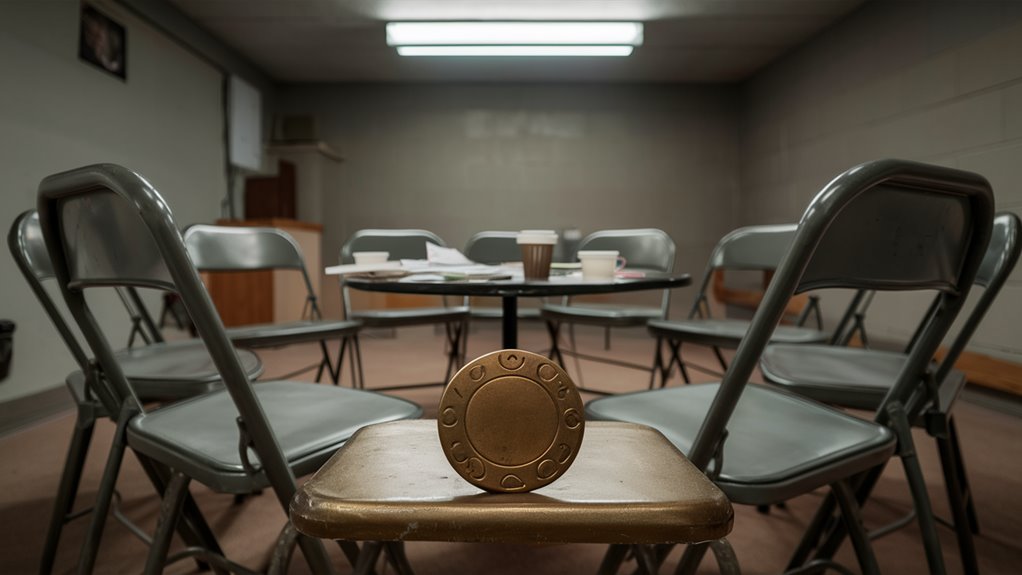
The Role of Gamblers Anonymous in Combating Gambling Addiction
Recovery Framework Based On Evidence
Gamblers Anonymous (GA) proven 12-step Haze & Hollow Casino recovery model provides a number of prevention strategies. The organization’s multi-modal treatment approach combines peer support meetings, sponsor mentor-student interactions, and behavioral monitoring systems to provide strong bases for both recovery and preventing addictions.
Recovery Gains Its Force from the Integration of Core Components
Evidence-Based Protocols is why GA is effective: Cognitive behavioral therapy techniques, Mindfulness-based practices, Structured accountability measures, Notification drills.
Methods of Recovery Support
GA’s prevention framework has multiple methods for support: Daily self-assessment protocols, Detailed recovery journaling, Achievement tracking systems, Behavioral modification techniques.
Support Network Integration
The organization helps form a fellowship-type support structure: Immediate emotional reinforcement, 24/7 crisis intervention access, Long-term recovery support.
Relapse Prevention Skills
Sustainable Recovery Practices
Seasoned Gamblers Anonymous members make durable recovery gains by means of: Regular meeting attendance, One-on-one sponsorperson assistance, Progressive milestone achievement, Community support network integration.
A programmatic approach guarantees that people with gambling addiction issues will receive both systemic support and necessary prevention tools that prepare them for sustained recovery from this illness.
Get to Know GA Support
Understanding the Support System of Gamblers Anonymous
Components Of the GA Support System
Gamblers Anonymous (GA) creates a complete support system based on its proven 12-step recovery model. The program integrates peer support communities with methods of behavior modification and structured systems for being accountable that all help addicts keep themselves out of harm’s way.
Meeting Situations and Support Networks
GA’s support system starts with regular recovery meetings. This forms the basis for support given by the other group members during times when a person’s relapse seems inevitable. These meetings are arranged on average every half hour throughout the day. The cornerstone of this program is the sponsor-sponsee relationship where old-timers provide guidance and mentorship at each stage along the path to recovery.
Role of Therapeutic Tools and Recovery Framework
The support system adopts evidence-based therapeutic tools such as: Daily self-assessment protocols, Trigger identification exercises, Progressive milestone tracking.
Multi-Modal Treatments
The GA method includes these three essential components: Standards of operation for fellowship meetings, Recovery education from the literature, Monitoring progress stage by stage, according to defined standards.
This program not only deals with a person’s psychological addiction, but also takes care of the need for social reform as well.

Explained in Our Previous Article, the Twelve Steps
Understanding the Twelve Steps: Full Recovery Guide For Success
The Foundation: Steps 1-3
Gamblers Anonymous’ Twelve Steps offer a structured therapeutic framework for recovery from addiction. The first three steps mainly break through denial and establish a new approach. At this critical stage, people recognize the powerless nature of their gambling, discover that other hands (gods) carry them along, and choose to relinquish control.
Analysis: Steps 4-7
The latter part of the middle section is taken up by self-examination and change. These steps are guided by an integrated model of cognitive development that help participants recognize habitual behavioral syndromes such as the cognitive distortions which are a cause for addictive behavior. Through rigorous self-examination, individuals identify harmful patterns Flickertrace Blackjack of thought and begin to create new ones.
Amends: Steps 8-9
Stages eight and nine are about mending relationships and taking responsibility for your own financial well-being. This time, which is so important to heal relations with those affected by gambling addictions, moves into the active mode. Participants develop concrete plans to make amends while continuing their journey of recovery.
Perseverance: Steps 10-12
The last few stages establish strategies for long-term recovery by means of: Continual self-assessment, Nice Recitation, Serving others in recovery situations, Building a good foundation of support.
Recovery on the Basis of Facts
Clinical investigations indicate that participants following this structured program have much better chances of long-term success. The nature of these steps is progressive. Working with a sponsor who has experience in ABI enhances program efficiency. This series of steps thus provides a comprehensive guide to recovery for people with gambling addiction that deals both in short-range and long-term issues.
Recovery Action
To follow this program successfully, you must: Stay with the plan, Commitment to sponsorship, Building a recovery community, Implementation of learned coping strategies.
Building a Recovery Community for Gambling Addiction
Hazardous gambling actions should be taken by the police if they have cause to do so or voluntarily by others with accompanying losses whose cause is readily traceable to common addictive disorders.
The Power of Recovery Networks
Gambling Inpatient Programs: The National Institute of Mental Health (NIMH) research department has made a very positive contribution to the field. Strong recovery networks significantly enhance treatment outcomes and minimize relapse risks for those overcoming gambling addiction.
Gamblers Anonymous (GA) meetings serve as foundational support hubs, connecting individuals with peers who intimately understand the recovery journey. Evidence-based research demonstrates that consistent peer support substantially increases abstinence rates and strengthens long-term recovery success.
Professional Support Integration
Recovery specialists play crucial roles in building comprehensive support systems: Addiction Counselors, Licensed therapists, Financial advisors, Recovery coaches.
These professionals provide expert advice and guidance for treating underlying issues and designing evidence-based recovery tools. Family support networks and non-gambling social connections further strengthen recovery foundations. Clinical studies consistently show that individuals maintaining diverse support networks achieve higher recovery success rates and demonstrate improved long-term behavioral modifications.
Recognizing Early Warning Signs
Financial Warning Signs
Unexplained financial difficulties often mark the first indicators of gambling problems. Watch for: Mounting debt from multiple sources, Frequent borrowing from family or friends, Selling valuable possessions to secure gambling funds, Hidden credit cards or undisclosed bank accounts. click here
Behavioral Red Flags
Behavioral changes typically manifest through: Secretive behavior around gambling activities, Defensive reactions to financial discussions, Social withdrawal from family and friends, Neglect of work responsibilities and personal obligations, Extended gambling sessions with increasing frequency.
Psychological Indicators
Mental and emotional warning signs include: Persistent urges to gamble, especially under stress, Preoccupation with past gambling experiences, Restlessness or irritability when attempting to stop gambling, Gambling more in hope of recouping past losses.
Early Warning Signs
Once there are more than merely a few warning signs, then taking measures right away becomes quite important: Seek help from counseling specialists in gambling, Draw a tight rein on your finances, Become involved in organizations that help people with gambling addiction, Establish responsibility-sharing relationships with trusted persons, Take yourself off the list of persons able to gamble.
When these warnings are picked up in the early stages, a pause in gambling may prevent the behavior from becoming impossible to control.
Tools for Lasting Behavioral Change
Evidence-Based Tools for Lasting Behavioral Change
Cognitive Behavioral Therapy for Gambling Recovery: The first step in treating gambling addiction is Cognitive Behavioral Therapy (CBT). This treatment plan targets the systematized thought patterns of people made obsessive by their habit and similar disorders.
Strategic Relapse Prevention Framework
Establishing effective prevention strategies requires systematic registration of the triggers at issue for gambling and the adoption of plans aimed in particular directions. This process should include: Methods for controlling exposure to stimuli, Planning for alternative behavior, Techniques from mindfulness that have been tested and found effective.
Progress Monitoring and Changes to Success Metrics
Quantified recovery metrics are crucial to keep track of how therapeutic progress is going. Important measurements include: Frequency of gambling urges, The number of continuous days without gambling, Recording tier of emotions, Your journal of recovery activities, Holding to your behavioral contract.
Stress Management Integration
Recovery outcomes are enhanced by evidence-supported techniques for reducing stress through these tools: Progressive relaxation of the muscles, Guided imagery sessions, Daily sessions of mindfulness exercises, Techniques for controlling emotional states.
Sustained Results
Structure of recovery communities is the key to success. Recovery is assured only through a combination of structured, evidence-based accountabilities linked to strong fellowship. Regular group participation cultivates various layers of responsibility: a sense of personal commitment, guiding mentors, and the support peer environment.
Leveraging The Fellowship Network
Strictly structured accountability check-ins become the cornerstone of effective recovery monitoring. Members report gambling triggers, urges, and potential setbacks through objective documentation. This tracking helps find behavior patterns that might otherwise get lost.
Dual Accountability Framework
The most effective recovery outcomes usually include two layers of accountability: Individual tutorials from primary sponsors, Group monitoring and offering mutual aid.
Combined, this approach sets out specific steps to take when the risk is high and provides corresponding action strategies aimed against compulsive gambling urges.


